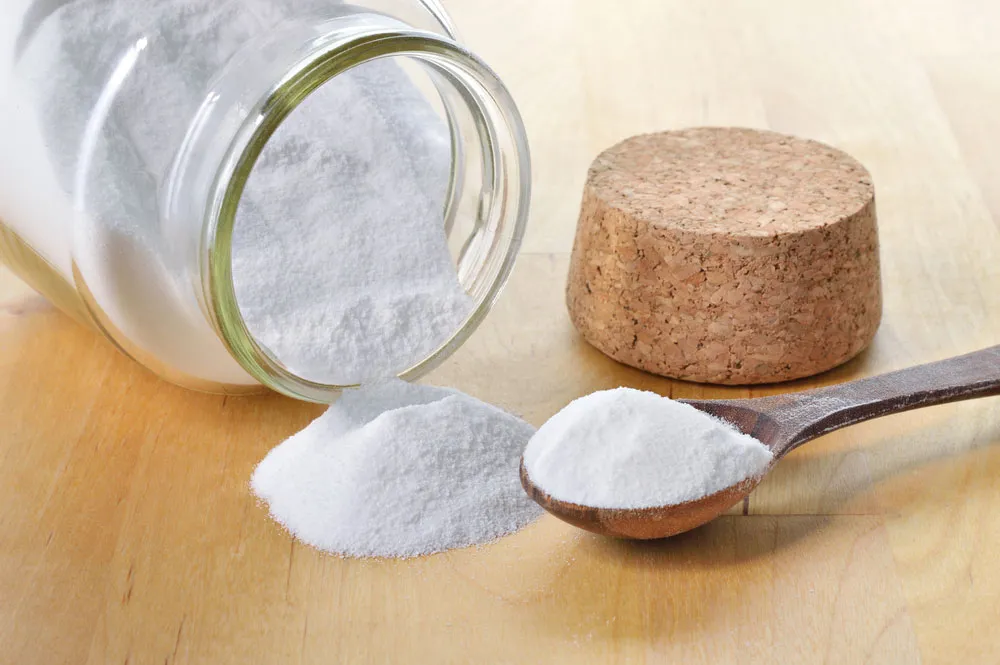Baking soda is usually used to remove dirt throughout the home. However, this eco-friendly cleaner can also be very useful in the garden or vegetable garden! It can be used to treat a yellowing lawn, fight mildew and invasive aphids. You can also use it to maintain your garden furniture. But above all, we do not always know that it is an excellent herbicide. However, if used properly, it can free you from the chore of manual weeding for weeds (bindweed, quackgrass, nettle, dandelion…). No more need for chemicals that are bad for the environment! Discover how to use your bicarbonate as a natural weed killer to chase away unwanted plants from your plantations.
Bicarbonate, commonly known as baking soda, can be an effective and natural weed killer when used correctly. Here’s how to make it an ultra-efficient weed killer:
Ingredients:
- Baking soda (bicarbonate of soda)
- Water
- Dishwashing liquid (optional)
- Sprayer or spray bottle
Contents
Instructions:
- Prepare the Mixture:
- In a container, mix baking soda with water. The recommended ratio is typically around 1 to 2 tablespoons of baking soda per gallon of water. You can adjust the concentration depending on the severity of the weed problem.
- Add Dishwashing Liquid (Optional):
- To improve the effectiveness of the solution, you can add a few drops of dishwashing liquid. This helps the mixture adhere to the weed leaves.
- Stir Thoroughly:
- Stir the mixture thoroughly to ensure the baking soda is well dissolved.
- Transfer to a Sprayer:
- Pour the solution into a sprayer or spray bottle for easy application.
- Apply to Weeds:
- On a dry, sunny day, spray the mixture directly onto the weeds, making sure to cover the leaves and stems thoroughly. Be cautious not to spray any desirable plants, as the solution can harm them as well.
- Repeat as Needed:
- Some weeds may require multiple applications for complete eradication. Reapply the mixture every few days until the weeds wither and die.
Tips for Using Bicarbonate as a Weed Killer:
- This method is most effective on small, young weeds and may not work as well on well-established or deeply rooted plants.
- Avoid spraying the solution on your garden plants or lawn, as baking soda can harm desirable vegetation.
- Be patient and persistent. It may take several applications to completely eliminate the weeds.
- This natural weed killer is best suited for paved areas like sidewalks and driveways, where you want to prevent weed growth in the cracks.
- While baking soda is generally safe for humans, pets, and the environment, using excessive amounts can disrupt the balance of the soil. Therefore, it’s important to use it judiciously and mainly for spot treatments.
Using bicarbonate as a weed killer can be an eco-friendly and cost-effective way to manage weeds in your garden or on hardscaped areas. Just remember to apply it carefully, especially around desirable plants, and reapply as needed to achieve the best results.
Why rely on it?
Just like mixtures based on boiling water (cooking water, salt water), coarse salt, dishwashing liquid, acetic acid (white vinegar) or black soap, bicarbonate is an ecological, biodegradable and very economical weedkiller. It will be the undeniable ally of gardeners who have banned the use of pesticides and other chemical plant protection products (fertilizers, pesticides, herbicides such as Glyphosate, etc.) in their outdoor spaces. Without danger for our health or that of our pets, it can be used without risk on all surfaces to eliminate weeds: gravel, patio tiles, walls … You do not risk damaging them! Properly applied, it also poses no risk to surrounding vegetation.
It is however necessary to respect the dosages well to drive out the undesirable grasses in a very effective way. It becomes phytotoxic (toxic for plants, and thus the weed) only above 1% in concentration.

How do you use your bicarbonate as a weed killer?
What you need:
Baking soda for food (in the salt aisle) or pharmaceutical baking soda (more expensive, in pharmacies).
Steps:
1) Schedule an application when the weather forecast calls for several days without inclement weather. Rainfall may dilute this natural product too much, making it ineffective. The morning dew will be more than enough to release its active ingredients to remove weeds.
2) Sprinkle your bicarbonate on the areas to be treated. In terms of quantity, count 20 g/m2 of water. Avoid the plants you want to keep: flowerbeds, lawns, flowerbeds…
3) Then let time do the rest. The weeds will disappear as time goes by. Repeat the operation once or twice a year.
That’s it! You now know how to control weeds in your garden paths. There are other solutions, of course (nettle or angelica manure, mulching, false seeding, elbow grease to pull everything out by hand…). Nevertheless, there is no doubt that bicarbonate is one of the easiest, most accessible and ecological solutions for the planet! In any case, no need to buy chemical weed killers anymore.










